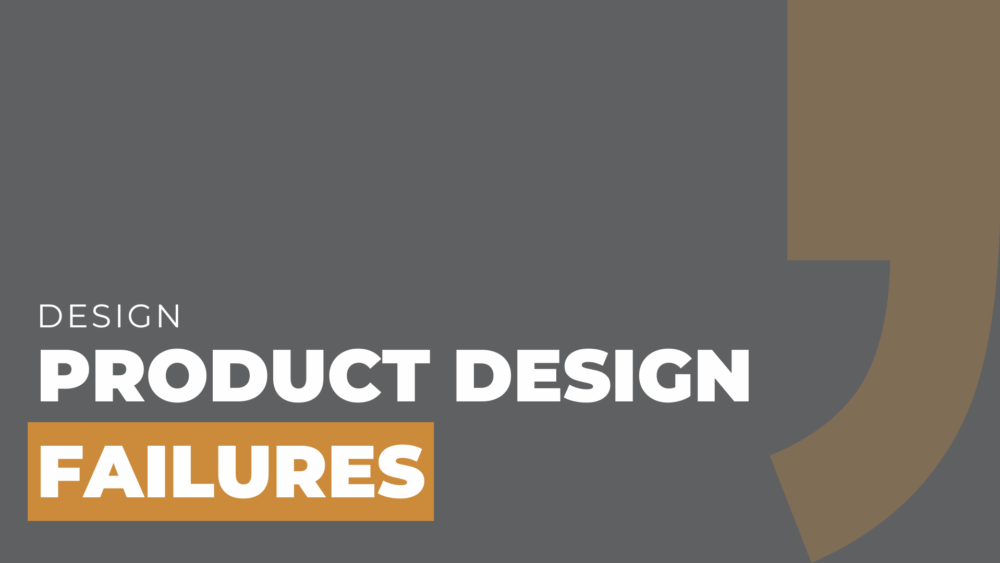Product design failures don’t just cost money—they cost trust, time, and team morale. For marketing directors, that’s the triple threat.
When a product flops, it’s your department fielding the firestorm, spinning PR, and dealing with returns. And most of the time, it’s not because the product idea was bad—it’s because the execution missed the mark. In this post, we’re breaking down what product design failures are, why they happen, and how to make sure they don’t happen to you.
What Causes Product Design Failures?
Design breakdowns usually stem from predictable issues. Here’s what leads to failure most often:
1. Skipping Market Research
According to CB Insights, 35% of startups fail because there’s no market need. That’s not a small miss—it’s the whole point of the product. When design teams don’t start with clear user insight, they create based on assumptions, not evidence.
This leads to designs that look good on a whiteboard but don’t resonate in the real world.
2. Cross-Functional Silos
Marketing, design, and engineering often speak different languages. And when they’re not aligned, features get misunderstood, brand goals get watered down, and teams start building for different outcomes.
A shared vision is what connects good ideas to great execution.
3. Rushed Launches
Speed-to-market pressure can be deadly. Pushing a product out to beat the competition—or meet a trade show deadline—often means skipping critical validation. Internal testing, user testing, and post-production reviews get trimmed or eliminated.
That short-term win? It’s often followed by long-term loss.
4. No Real-World Testing
A survey from the Design Management Institute found that design-led companies outperform the S&P by 219%. Why? Because they test. They listen. They iterate. Failure often comes from launching too soon without testing for usability, accessibility, or basic functionality in the hands of real users.
What Happens When Product Design Fails?
Let’s say it goes live. It’s out in the market. Then the cracks show.
1. Your Reputation Takes the Hit
According to Forbes, negative online reviews influence 94% of consumers’ decisions. One design flaw—especially in today’s always-on social landscape—can spread fast and define your brand in minutes.
2. Customers Leave (And Tell Everyone)
Returns, refunds, and negative word-of-mouth can ripple across multiple quarters. Bain & Company reports that a 5% increase in customer retention increases profits by 25% to 95%. Poor product design has the opposite effect: it repels loyalty.
3. Internal Teams Burn Out
Your team’s scrambling. Customer service is overwhelmed. Sales doesn’t want to pitch the product. And marketing? They’re trying to clean up a mess they didn’t make—all while under the microscope of leadership.
Famous Product Design Failures (and What They Teach Us)
Samsung Galaxy Note 7 (2016)
This flagship phone was recalled not once, but twice due to its battery catching fire. It led to a full discontinuation and a $5.3 billion loss.
Lesson: Safety testing should never be optional—no matter how sleek your design looks.
Google Glass (2013)
It promised futuristic functionality, but flopped due to privacy concerns, limited use, and a sky-high price.
Lesson: Innovation without public trust is just expensive noise.
Juicero (2016)
The $400 juicer was exposed when users found they could squeeze juice packs by hand. The product became a punchline and shut down in 2017.
Lesson: Don’t overengineer. Solve problems users actually have.
Apple Butterfly Keyboard (2015–2019)
Apple’s thinner keyboard design was beautiful—but flawed. Keys stuck. Dust broke it. The backlash forced Apple into multi-year repairs and a return to the previous keyboard.
Lesson: If it doesn’t work reliably, nobody cares how slim it is.
How to Prevent Product Design Failures
This is where most brands miss the mark—not in ideas, but in the process.
1. Begin with Actual Research
Interview real users. Analyze competitor gaps. Understand behavior, not just preferences. Ground your design in actual demand—not stakeholder opinions.
This is the only way to anchor a product in reality. Your product design should serve a need your audience truly feels.
2. Keep Teams Fully Aligned
Avoid building in silos. Sync marketing, product, and design goals in a shared workspace. Clear ownership, frequent feedback loops, and mutual timelines help avoid last-minute chaos.
3. Develop a Solid Product Design Roadmap
A product design roadmap isn’t a luxury—it’s a requirement. This includes timelines, testing phases, handoff points, and internal review cycles. It protects your team from surprises and your product from slipping through cracks.
4. Test Early, Often, and Honestly
Use clickable prototypes. Hold moderated user testing. Run pre-launch pilots. Don’t just seek praise—look for friction. If the product breaks in private, you can fix it. If it breaks in public, you explain it.
What Is the Product Design Definition?
The product design definition is more than aesthetics. It’s the strategic process of identifying a problem, developing a solution, and designing a product that is functional, usable, and desirable.
Design isn’t just about how something looks—it’s about how it works. And works well. For the people who matter: your audience.
At The End Of The Day
Product design failures are preventable.
With the right roadmap, research, and cross-team accountability, your product won’t just look good—it’ll work. That’s the kind of product design that sells itself and strengthens your brand.
At the end of the day, avoiding product design failures comes down to clarity, testing, and listening to your users. It’s not easy. But it is possible—with the right partner.
Let’s Build Products That Actually Work
You’ve got enough to worry about—product failure shouldn’t be one of them.
MOCK, the agency, helps marketing leaders prevent product design disasters before they start. We partner with your team to create designs that work, resonate, and convert. Whether you need smarter strategy, tighter execution, or fresh creative eyes—we’re your people.
Let’s take the weight off your shoulders and put the results back in your hands.
- Website: https://mocktheagency.com/
- Phone: 470-225-6814
- Email: hello@mocktheagency.com
- Address: 247 14th St NW, Atlanta, GA 30318


Comments are closed.